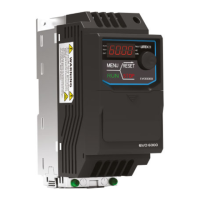69
Overshoot Suppression
When an overshoot occurs, reduce the derivative time set to b5-04 and increase the integral
time set to b5-02.
Stability after Overshoot.
To immediately achieve stability after an overshoot, increase the derivative time set to b5-04
and reduce the integral time set to b5-02.
Long Cycle Oscillation Suppression
If the oscillation cycle is longer than the integral time set to b5-02, increase the time as the
integral operation is too strong.
Short Cycle Oscillation Suppression
If the oscillation cycle is almost the same as the derivative time set to b5-04, reduce the time as
the derivative operation is too strong.
If even 0.00 derivative time (D control disabled) cannot suppress the oscillation, reduce the P
Gain set to b5-01 or increase the PID Primary Delay Time set to b5-07.
b5- 28 PID Disconnection Output Frequency
When a PID feedback disconnection alarm occurs, the drive will run at the frequency set to
b5-28, and return to PID control when disconnection alarm is reset.
PID Disconnection Output Frequency
<1> The upper limit is determined by the values set to d1-02 (Maximum Output Frequency), d1-13 (Motor 2
Maximum Output Frequency) and L2-00 (Frequency Command Upper Limit).
6.3 Group C, Tuning
C1 Acceleration and Deceleration Time
C1- 00 to C1- 03 Acceleration and Deceleration Times 1 to 4
Four different acceleration and deceleration times can be set in the drive by multi-function
input terminals, motor selection or switched during run.
Set the acceleration time to determine the time needed to accelerate from 0Hz to the
maximum frequency (d1-02). Set the deceleration time to determine the time needed to

